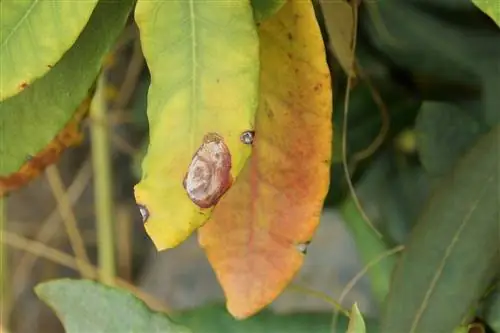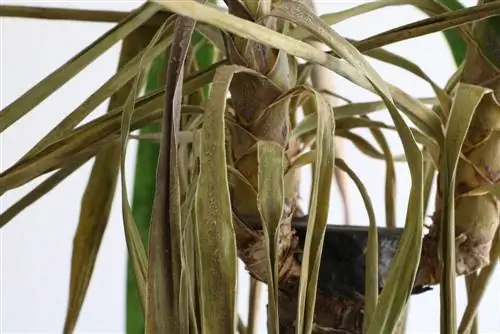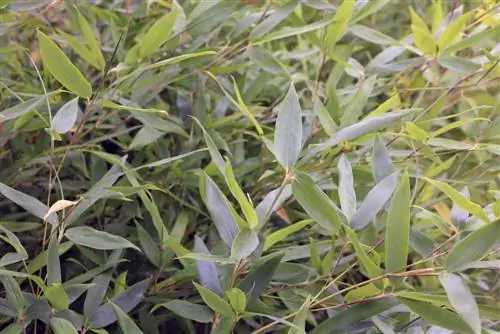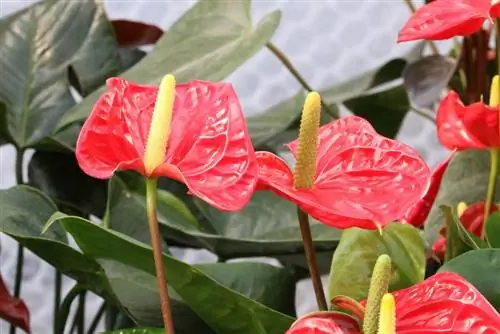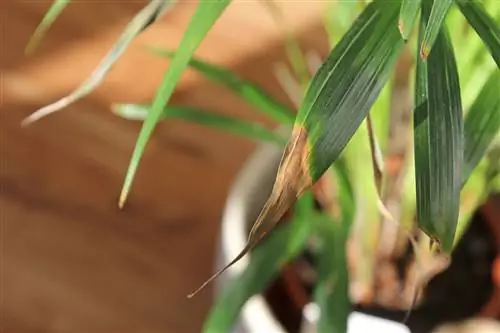- Author admin [email protected].
- Public 2023-12-17 03:39.
- Last modified 2025-01-24 12:45.
Even with the best care of houseplants, it can happen that the green or flowering plants suddenly get yellow or brown leaves. Pests can be ruled out in most cases. An incorrect location, too much or too little moisture or incorrect humidity can be to blame for the symptoms. Other causes may lie in the substrate or be caused by incorrect fertilizer. In order to save the plant, hobby gardeners should quickly and comprehensively find out about the ideal growing conditions for their protégés. By quickly identifying care errors, the plants can be saved.
Location
If the leaves become more and more yellow, then too much or too little light may be to blame. If you like a shady location but are in the blazing sun, you will get yellow leaves that later turn brown at the edges and then fall off. The damage occurs due to overheating of the leaf tissue. Due to the heat and dry air, brown leaf tips can appear at the same time, the brown coloring of which increases the longer the plant is in the unsuitable location. First aid measures can include shading or a change of location.
Pouring
Too little water can cause the leaves of houseplants to turn yellow, while too much water leads to brown leaves. Depending on the color of the leaves, the plant receives too many or too few nutrients.
Tip:
If there is a lack of water, immerse the plant in a bowl or bucket with lukewarm water until the root ball is saturated again.
If the plant is too moist, you should stop watering immediately and, if necessary, repot the plant from the moist substrate into dry substrate with plenty of drainage. You must remove the rotten roots. If plants are watered with hard water, chlorosis can occur. Citrus plants are particularly sensitive to this. Possible damage and possible remedies:
- the leaves turn yellow, the leaf veins remain green - general nutrient deficiency: can be eliminated by giving fast-acting complete fertilizer
- first older leaves turn yellow from the tip, later younger leaves too - nitrogen deficiency: apply nitrogen fertilizer quickly
- the leaves turn yellow including the leaf veins - waterlogging: replace the substrate immediately
- young leaves turn yellow overall - iron deficiency: give special iron fertilizer, place plant in acidic substrate
- large yellow spots on the leaves of plants with soft leaves - irrigation water that is too cold: water plants with lukewarm water and do not wet the leaves
- Older leaves turn yellow at the edge, the center of the leaf remains green - magnesium deficiency: give fertilizer containing magnesium, if necessary replace the substrate
Tip:
Yellowing of the leaves often occurs in angel trumpets due to nitrogen deficiency. Camellias, on the other hand, turn their leaves yellow when watered with hard water.
Damage caused by the plant substrate
If the potting soil is not replaced for a long time, the substrate becomes enriched with s alts due to watering. Over time, these crystallize and form a white coating on the edges of the pot, which can even penetrate to the outside of clay pots. The s alts are also deposited on the roots. The plant receives fewer nutrients. This causes the leaves to become limp and brown and eventually curl and later fall off. The plant dies. In the early stages, replacing the planting substrate helps. If the same flower pot is used again, it should be cleaned thoroughly with a brush to remove the white deposits.
Too cool temperatures
Some houseplants require a very specific temperature threshold to thrive. If this is not achieved, leaf discoloration and leaf fall will occur. Radiant aralia, dieffenbachia and the poinsettia turn yellow and later drop their leaves. This damage cannot be reversed. Yellow leaves can also be caused by drafts, which cause “cold feet” for houseplants. Insulating Styrofoam panels as coasters can help. If rot also occurs on the substrate, it can help to replace the substrate and remove rotting roots.
Tip:
For tropical plants, the temperature threshold can be as low as +15 °C!
Brown leaves on palm trees
To determine the cause of the brown color, you must check your care habits, because brown leaves on palm trees can have different causes. They are caused by too much water, too little water or over-fertilization. You can cut off dead fronds immediately. Now check the substrate. If it is too dry, water your palm tree generously with lukewarm water. The weak leaves that remained green should recover after some time. If you water too much, it helps to pot up the palm tree and look at the roots. Roots that are already rotting are removed and the palm tree is potted in new substrate.
Tip:
Do not water the palm tree for a few weeks!
If a nutrient deficiency is the reason for the yellow or brown discoloration, then giving fertilizer tailored to palm trees will help. Brown leaf tips on palm trees, on the other hand, indicate a lack of humidity. It helps here to spray over the exotic plants more often. Succulents, on the other hand, get brown leaves from too much water.
Check malicious images carefully
Take a close look at your ailing houseplants. If pest insects appear, affected parts of the plant are removed, the plant is rinsed or the pot is immersed in a bucket of water so that the pests drown. Fungicides from specialist plant shops can help against fungal infestation, which can be recognized by round brown spots on the leaves. If the infestation is very severe, the plant must be disposed of. In the case of gray mold, which causes the leaves to turn brown and creates a dusty gray coating over the leaves, it helps to quickly remove the affected parts and keep the plant airy and bright. Gray mold can be avoided if the plant is given a suitable location and any wilted and dead plants are removed immediately.
Frequently asked questions
What damage is caused by a spider mite infestation?
The leaves turn yellow and the buds fall off, the plant is covered in a fine web.
How can you get rid of thrips?
Leaf shine agents work surprisingly well against thrips. However, they cannot be used on ferns or soft, hairy leaves.
What helps with over-fertilization?
It is best to replace the substrate.
What you should know about discolored leaves on plants
Houseplants
- Yellow leaves can have various causes. These include overwatering, a lack of nitrogen, and a location that is too dark, warm or too cool. Then the only thing that helps is to limit watering, fertilize and improve the location.
- Brown leaf edges are usually caused by incorrect watering, regardless of whether you water too much or too little. The soil can also be worn out, the air too dry or you have over-fertilized. The care errors must be corrected immediately.
- Brown leaf tips are usually an indication that the air is too dry or the ball is dry. You simply ensure higher humidity and water heavily. Excess water must be removed, because waterlogging is not good either.
- Brown leaf spots indicate a fungus, usually leaf spot fungus. You can recognize them by the partially surrounded spore beds. The cause is an infection. Diseased plant parts must be removed. If necessary, selected fungicides can be used.
- Rust-colored dust heaps on the underside of the leaves and light spots on the upper side indicate the rust fungus. The fungi are often introduced. Here too, affected leaves must be removed and fungicides used if necessary.
potted plants
- Container plants often get brown leaves during overwintering. But mostly this is normal. During winter dormancy, watering is sparing and there are no nutrients. Not all leaves survive this. In the spring, when watering and fertilizing are carried out again, this should subside.
- If leaves otherwise get brown edges or turn completely brown, this is usually due to too much or too little water. Potted plants need to be watered frequently in summer because the roots cannot store much water in the pots, which are often too small. In addition, the air is too dry for many potted plants in summer and they need sufficiently high humidity.
- Yellow leaves are usually due to a lack of nitrogen. Fertilization should be targeted here.
- Otherwise, fungal infections can lead to brown leaf spots. The affected plant parts must be removed. A fungicide usually has to be used to prevent the disease from spreading.
Garden Plants
- Many garden plants tend to have yellow and brown leaves, especially after a new planting. This usually comes from stress. They have been dug up, have a new location and new growing conditions. As soon as the plants get used to it, this will happen.
- Stress also often leads to fungal infestation. Even then the leaves turn brown or have brown leaf spots. Affected leaves are removed. Chemical agents often have to be used to eradicate the fungus.
- Frost also causes brown leaves. This can always be seen particularly clearly in the cherry laurel.
- Yellow leaves in garden plants are often due to a nitrogen deficiency. Targeted fertilization can help.
- Fungus can also cause yellow leaves, such as Monilia laxa. However, yellow leaves are often due to drought damage after new plantings.

